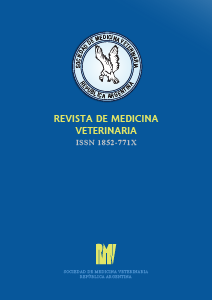Ver ítem
- xmlui.general.dspace_homeCentros e Institutos de InvestigaciónCIAP. Centro de Investigaciones AgropecuariasInstituto de Investigación Animal del Chaco SemiáridoArtículos científicosxmlui.ArtifactBrowser.ItemViewer.trail
- Inicio
- Centros e Institutos de Investigación
- CIAP. Centro de Investigaciones Agropecuarias
- Instituto de Investigación Animal del Chaco Semiárido
- Artículos científicos
- Ver ítem
Nematodes gastrointestinales de importancia económica en la producción bovina del Noroeste Argentino
Resumen
El objetivo del presente estudio fue describir la etiología y abundancia de los nematodes gastrointestinales (NGI) de los vacunos en los diferentes sistemas productivos y ecorregiones del noroeste de Argentina. Los NGI se recuperaron de muestras provenientes de necropsias realizadas con motivo de casos diagnósticos diversos (n= 47) y de muestras de frigoríficos (n= 9) provenientes de las
ecorregiones Chaqueña semiárida, Chaco serrano y Valles templados
[ver mas...]
El objetivo del presente estudio fue describir la etiología y abundancia de los nematodes gastrointestinales (NGI) de los vacunos en los diferentes sistemas productivos y ecorregiones del noroeste de Argentina. Los NGI se recuperaron de muestras provenientes de necropsias realizadas con motivo de casos diagnósticos diversos (n= 47) y de muestras de frigoríficos (n= 9) provenientes de las
ecorregiones Chaqueña semiárida, Chaco serrano y Valles templados de Salta, Jujuy, Tucumán y Santiago del Estero. Durante el período 2012-2018, a partir de las muestras del cuajo e intestinos se procedió a la recuperación y recuento de NGI. Las diferencias en los conteos de las especies de NGI fueron procesadas por análisis de varianza no paramétricos. Los NGI hallados y sus respectivas prevalencias fueron Cooperia pectinata (73%), Cooperia punctata (64%), Haemonchus placei (73%), Trichostrongylus axei (46%) y Ostertagia ostertagi (41%). Esporádicamente se recuperaron Oesophagostomum radiatum y Trichuris spp. Se evidenciaron diferencias significativas en los recuentos de Haemonchus placei (p<0,006), Cooperia punctata (p<0,0004), C. pectinata (p<0,0001) entre terneros y vacunos adultos. Las cargas de Ostertagia ostertagi recuperadas en los tambos fueron significativamente (p<0,025) más altas que las halladas en cría o engorde a corral. Independientemente de las ecorregiones, las poblaciones de O. ostertagi como de T. axei fueron significativamente (p<0,0001) más numerosas por sobre los 1000 m s.n.m., mientras que las de H. placei fueron mayores (p<0,02) por debajo de los 1000 m s.n.m. Se concluye que estas cinco especies son las de mayor importancia productiva para los bovinos de acuerdo a las diferentes regiones, altitudes y sistemas productivos.
[Cerrar]
Gastrointestinal nematodes of economic importance in bovine production of the Argentine Northwest The aim of this study was to describe the etiology and abundance of cattle gastrointestinal nematodes (GIN) in different productive systems and ecological regions of Argentina´s Northwestern. GIN were recovered from samples collected from necropsies carried out for different diagnostic
cases (n= 47) and from slaughter samples (n= 9) from the following
[ver mas...]
Gastrointestinal nematodes of economic importance in bovine production of the Argentine Northwest The aim of this study was to describe the etiology and abundance of cattle gastrointestinal nematodes (GIN) in different productive systems and ecological regions of Argentina´s Northwestern. GIN were recovered from samples collected from necropsies carried out for different diagnostic
cases (n= 47) and from slaughter samples (n= 9) from the following regions: Chaqueña semi-arid, Chaco serrano, and Temperate valleys of the provinces of Salta, Jujuy, Tucumán and Santiago del Estero. During the 2012-2018 period, from abomasum and intestines samples GIN were recovered and counted. GIN species count differences were processed by non-parametric variance analysis. Recovered NGI and their respective prevalences were Cooperia pectinata (73%), Cooperia punctata (64%), Haemonchus placei (73%), Trichostrongylus axei (46%) and Ostertagia ostertagi (41%). Oesophagostomum radiatum and Trichuris spp. were occasionally recovered. Significant differences in Haemonchus placei counts (p <0.006), Cooperia punctata (p <0.0004), C. pectinata (p <0.0001) between calves and adult bovines were evidenced. Ostertagia ostertagi burdens recovered from dairy systems were significantly (p <0.025) higher than those found in breeding or fattening systems. Regardless of the ecological regions both O.
ostertagi and T. axei populations were significantly (p <0.0001) more numerous over 1000 m a.s.l., while those of H. placei were significantly (p <0.02) higher below 1000 m a.s.l. It is concluded that these five species are those of most productive importance species according to different regions, altitude above sea level and production systems.
[Cerrar]

Fuente
Revista de Medicina Veterinaria 100 (3) : 1-7 (2019)
Fecha
2019-11-16
Editorial
Sociedad de Medicina Veterinaria (Argentina)
ISSN
1852-771X
Formato
pdf
Tipo de documento
artículo
Palabras Claves
Derechos de acceso
Abierto
 Excepto donde se diga explicitamente, este item se publica bajo la siguiente descripción: Creative Commons Attribution-NonCommercial-ShareAlike 2.5 Unported (CC BY-NC-SA 2.5)
Excepto donde se diga explicitamente, este item se publica bajo la siguiente descripción: Creative Commons Attribution-NonCommercial-ShareAlike 2.5 Unported (CC BY-NC-SA 2.5)


